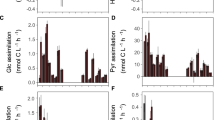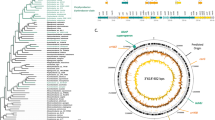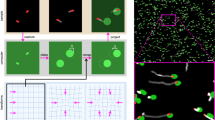Abstract
Aerobic anoxygenic phototrophic (AAP) bacteria are photoheterotrophs that despite their low abundances have been hypothesized to play an ecologically and biogeochemically important role in aquatic systems. Characterizing this role requires a better understanding of the in situ dynamics and activity of AAP bacteria. Here we provide the first assessment of the single-cell activity of freshwater AAP bacteria and their contribution to total bacterial production across lakes spanning a wide trophic gradient, and explore the role of light in regulating AAP activity. The proportion of cells that were active in leucine incorporation and the level of activity per cell were consistently higher for AAP than for bulk bacteria across lakes. As a result, AAP bacteria contributed disproportionately more to total bacterial production than to total bacterial abundance. Interestingly, although environmentally driven patterns in activity did not seem to differ largely between AAP and bulk bacteria, their response to light did, and exposure to light resulted in increases in the proportion of active AAP bacteria with no clear effect on their cell-specific activity. This suggests that light may play a role in the activation of AAP bacteria, enabling these photoheterotrophs to contribute more to the carbon cycle than suggested by their abundance.
Similar content being viewed by others
Log in or create a free account to read this content
Gain free access to this article, as well as selected content from this journal and more on nature.com
or
References
Biebl H, Wagner-Döbler I . (2006). Growth and bacteriochlorophyll a formation in taxonomically diverse aerobic anoxygenic phototrophic bacteria in chemostat culture: influence of light regimen and starvation. Process Biochem 41: 2153–2159.
Béjà O, Suzuki MT . (2008). Photoheterotrophic marine prokaryotes. In: Kirchman David L (ed). Microbial Ecology of the Oceans. John Wiley & Sons: Hoboken, NJ, USA, pp 131–157.
Cottrell MT, Kirchman DL . (2003). Contribution of major bacterial groups to bacterial biomass production (thymidine and leucine incorporation) in the Delaware estuary. Limnol Oceanogr 48: 168–178.
Cottrell MT, Kirchman DL . (2009). Photoheterotrophic microbes in the Arctic Ocean in summer and winter. Appl Environ Microbiol 75: 4958–4966.
Cottrell MTM, Mannino A, Kirchman DL . (2006). Aerobic anoxygenic phototrophic bacteria in the Mid-Atlantic Bight and the North Pacific Gyre. Appl Environ 72: 557–564.
Del Giorgio PA, Gasol JM . (2008). Physiological structure and single-cell activity in marine bacterioplankton. In: Kirchman DL (ed). Microbial Ecology of the Oceans. John Wiley & Sons: NJ, USA, pp 243–298.
Fauteux L, Cottrell MT, Kirchman DL, Borrego CM, Garcia-Chaves MC, del Giorgio PA . (2015). Patterns in Abundance, Cell Size and Pigment Content of Aerobic Anoxygenic Phototrophic Bacteria along Environmental Gradients in Northern Lakes. PLoS One 10: e0124035.
Ferrera I, Borrego CM, Salazar G, Gasol JM . (2013). Marked seasonality of aerobic anoxygenic phototrophic bacteria in the coastal NW Mediterranean Sea as revealed by cell abundance, pigment concentration and pyrosequencing of pufM gene. Environ Microbiol 16: 2953–2965.
Ferrera I, Gasol JM, Sebastián M, Hojerová E, Koblízek M . (2011). Comparison of growth rates of aerobic anoxygenic phototrophic bacteria and other bacterioplankton groups in coastal Mediterranean waters. Appl Environ Microbiol 77: 7451–7458.
Garcia-Chaves M, Cottrell M, Kirchman D, Derry A, Bogard M, del Giorgio PA . (2015). Major contribution of both zooplankton and protists to the top-down regulation of freshwater aerobic anoxygenic phototrophic bacteria. Aquat Microb Ecol 76: 71–83.
Hauruseu D, Koblížek M . (2012). The influence of light on carbon utilization in aerobic anoxygenic phototrophs. Appl Environ Microbiol 78: 7414–7419.
Hojerová E, Mašín M, Brunet C, Ferrera I, Gasol JM, Koblížek M . (2011). Distribution and growth of aerobic anoxygenic phototrophs in the Mediterranean Sea. Environ Microbiol 13: 2717–2725.
Kirchman D, Stegman M, Nikrad M, Cottrell MT . (2014). Abundance, size, and activity of aerobic anoxygenic phototrophic bacteria in coastal waters of the West Antarctic Peninsula. Aquat Microb Ecol 73: 41–49.
Kirchman DL, Hanson TE . (2013). Bioenergetics of photoheterotrophic bacteria in the oceans. Environ Microbiol Rep 5: 188–199.
Koblízek M, Masín M, Ras J, Poulton AJ, Prásil O . (2007). Rapid growth rates of aerobic anoxygenic phototrophs in the ocean. Environ Microbiol 9: 2401–2406.
Koblízek M, Stoń-Egiert J, Sagan S, Kolber ZS . (2005). Diel changes in bacteriochlorophyll a concentration suggest rapid bacterioplankton cycling in the Baltic Sea. FEMS Microbiol Ecol 51: 353–361.
Koblížek M . (2015). Ecology of aerobic anoxygenic phototrophs in aquatic environments. FEMS Microbiol Rev 39: 854–870.
Lamy D, Jeanthon C, Cottrell MT, Kirchman DL, Van Wambeke F, Ras J et al. (2011). Ecology of aerobic anoxygenic phototrophic bacteria along an oligotrophic gradient in the Mediterranean Sea. Biogeosciences 8: 973–985.
Liu R, Zhang Y, Jiao N . (2010). Diel variations in frequency of dividing cells and abundance of aerobic anoxygenic phototrophic bacteria in a coral reef system of the South China Sea. Aquat Microb Ecol 58: 303–310.
Moran MA, Miller WL . (2007). Resourceful heterotrophs make the most of light in the coastal ocean. Nat Rev Microbiol 5: 792–800.
Salcher MM, Posch T, Pernthaler J . (2013). In situ substrate preferences of abundant bacterioplankton populations in a prealpine freshwater lake. ISME J 7: 896–907.
Salka I, Moulisová V, Koblízek M, Jost G, Jürgens K, Labrenz M et al. (2008). Abundance, depth distribution, and composition of aerobic bacteriochlorophyll a-producing bacteria in four basins of the central Baltic Sea. Appl Environ Microbiol 74: 4398–4404.
Sieracki M, Gilg I, Thier E, Poulton NJ, Goericke R . (2006). Distribution of planktonic aerobic anoxygenic photoheterotrophic bacteria in the northwest Atlantic. Limnol Oceanogr 51: 38–46.
Sieracki M, Viles C, Webb K . (1989). Algorithm to estimate cell biovolume using image analyzed microscopy. Cytometry 10: 551–557.
Sintes E, Herndl GJ . (2006). Quantifying substrate uptake by individual cells of marine bacterioplankton by catalyzed reporter deposition fluorescence in situ hybridization combined with microautoradiography. Appl Environ Microbiol 72: 7022–7028.
Smith DC, Azam F . (1992). A simple, economical method for measuring bacterial protein synthesis rates in seawater using 3H-leucine 1. Mar Biol Res 6: 107–114.
Smith E, del Giorgio PA . (2003). Low fractions of active bacteria in natural aquatic communities? Aquat Microb Ecol 31: 203–208.
Spring SS, Lünsdorf HH, Fuchs BMBM Tindall BJBJ . (2009). The photosynthetic apparatus and its regulation in the aerobic gammaproteobacterium Congregibacter litoralis gen. nov., sp. nov. PLoS One 4: e4866.
Stegman MR, Cottrell MT, Kirchman DL . (2014). Leucine incorporation by aerobic anoxygenic phototrophic bacteria in the Delaware estuary. ISME J 8: 2339–2348.
Yurkov V, Csotonyi J . (2009). New light on aerobic anoxygenic phototrophs. In: Hunter CN, Daldal F, Thurnauer M, Beatty JT (eds). The Purple Phototrophic Bacteria. Advances in Photosynthesis and Respiration vol. 28 Springer: The Netherlands, pp 31–55.
Acknowledgements
We thank AC Mesa, M Morales, K Bareil-Parenteau, A Heathcote and L Yu for field and laboratory assistance, A Parkes, D Vachon and JP Niño for their comments and suggestions on this manuscript and HSC for inspiration. This research was supported by grants from the National Science and Engineering Research Council of Canada (NSERC) to PA del Giorgio.
Author information
Authors and Affiliations
Corresponding author
Ethics declarations
Competing interests
The authors declare no conflict of interest.
Additional information
Supplementary Information accompanies this paper on The ISME Journal website
Supplementary information
Rights and permissions
About this article
Cite this article
Garcia-Chaves, M., Cottrell, M., Kirchman, D. et al. Single-cell activity of freshwater aerobic anoxygenic phototrophic bacteria and their contribution to biomass production. ISME J 10, 1579–1588 (2016). https://doi.org/10.1038/ismej.2015.242
Received:
Revised:
Accepted:
Published:
Issue date:
DOI: https://doi.org/10.1038/ismej.2015.242
This article is cited by
-
Diurnal cycles drive rhythmic physiology and promote survival in facultative phototrophic bacteria
ISME Communications (2023)
-
Photoheterotrophy by aerobic anoxygenic bacteria modulates carbon fluxes in a freshwater lake
The ISME Journal (2022)
-
The role of methanotrophy in the microbial carbon metabolism of temperate lakes
Nature Communications (2022)
-
Soil Chemistry and Nutrients Influence the Distribution of Aerobic Anoxygenic Phototrophic Bacteria and Eukaryotic Phototrophic Microorganisms of Physical Soil Crusts at Different Elevations on the Tibetan Plateau
Microbial Ecology (2022)
-
Seasonal dynamics of aerobic anoxygenic phototrophs in freshwater lake Vlkov
Folia Microbiologica (2019)



